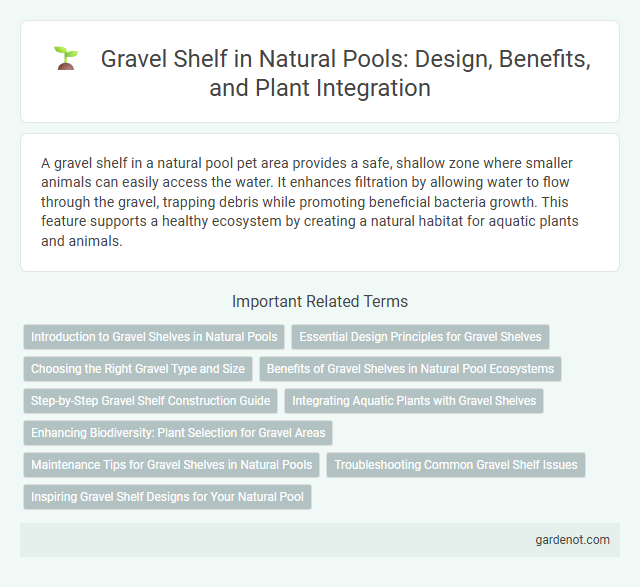A gravel shelf in a natural pool pet area provides a safe, shallow zone where smaller animals can easily access the water. It enhances filtration by allowing water to flow through the gravel, trapping debris while promoting beneficial bacteria growth. This feature supports a healthy ecosystem by creating a natural habitat for aquatic plants and animals.
Introduction to Gravel Shelves in Natural Pools
Gravel shelves in natural pools create a shallow, transitional zone that supports aquatic plants and enhances habitat diversity. These shelves improve water filtration by trapping sediments and provide a gentle slope for safe entry and exit. Integrating gravel shelves promotes ecological balance and aesthetic appeal by blending natural materials with the pool's design.
Essential Design Principles for Gravel Shelves
Gravel shelves in natural pools serve as critical biofilters, promoting water circulation and providing a habitat for beneficial microorganisms that aid in nutrient breakdown. Essential design principles include ensuring the shelf is shallow enough to maintain ample sunlight penetration for aquatic plants while allowing easy access for small fauna. Proper layering of gravel with varying particle sizes enhances filtration efficiency and supports diverse plant root structures, contributing to a balanced aquatic ecosystem.
Choosing the Right Gravel Type and Size
Selecting the appropriate gravel type and size for a natural pool gravel shelf is crucial for water filtration and habitat stability. Opt for rounded river gravel with a diameter between 8 to 20 millimeters to ensure efficient water flow while minimizing sediment buildup. Proper gravel selection supports beneficial bacterial growth and maintains clear, balanced water conditions in the natural pool ecosystem.
Benefits of Gravel Shelves in Natural Pool Ecosystems
Gravel shelves in natural pool ecosystems enhance water filtration by trapping sediments and promoting the growth of beneficial microorganisms that break down pollutants. These shelves provide essential habitat for aquatic plants and invertebrates, supporting biodiversity and stabilizing the ecosystem. Gravel shelves also aid in maintaining water clarity and oxygen levels, contributing to the overall health and balance of the natural pool environment.
Step-by-Step Gravel Shelf Construction Guide
Gravel shelf construction in a natural pool involves excavating a shallow ledge around the pool perimeter to support aquatic plants and promote biological filtration. Begin by marking the designated shelf area, then excavate to a consistent depth of 15-30 cm, ensuring a gentle slope for water circulation. Lay a geotextile membrane, then place a 5-10 cm layer of washed gravel, gradually compacted to create a stable and porous base for plant rooting and habitat development.
Integrating Aquatic Plants with Gravel Shelves
Gravel shelves in natural pools create a shallow zone ideal for integrating aquatic plants that improve water quality by filtering nutrients and providing oxygen. Selecting native species such as reeds, rushes, and water lilies enhances biodiversity and supports natural filtration processes. Properly designed gravel shelves stabilize plant roots while maintaining water circulation essential for a balanced ecosystem.
Enhancing Biodiversity: Plant Selection for Gravel Areas
Gravel shelves in natural pools serve as crucial transitional zones that support diverse aquatic plant species adapted to shallow, well-drained conditions. Selecting native plants such as water irises, sedges, and rushes enhances biodiversity by providing habitats for amphibians, insects, and microorganisms. This plant diversity promotes balanced ecosystems and natural filtration, improving water quality and overall pool health.
Maintenance Tips for Gravel Shelves in Natural Pools
Regular removal of debris and organic matter from the gravel shelf prevents clogging and maintains water clarity in natural pools. Periodic rinsing with a gentle water flow helps to dislodge trapped sediments and supports healthy aquatic plant growth. Monitoring gravel depth and replenishing as needed ensures optimal filtration and ecosystem balance.
Troubleshooting Common Gravel Shelf Issues
Gravel shelves in natural pools often face clogging issues due to organic debris accumulation, which reduces water flow and affects filtration efficiency. Regular maintenance, including debris removal and gravel agitation, helps restore proper water circulation and prevents anaerobic conditions. Monitoring shelf depth and slope adjustments can also mitigate sediment buildup and ensure optimal filtration performance.
Inspiring Gravel Shelf Designs for Your Natural Pool
Gravel shelves in natural pools create a shallow, gently sloping area that enhances aquatic plant growth and promotes natural filtration. Designs incorporating varying gravel sizes and native plants not only boost biodiversity but also provide an aesthetically pleasing transition from water to land. Strategic placement of gravel shelves improves water clarity and supports a balanced ecosystem, making them essential features for eco-friendly natural pool landscaping.
Gravel shelf Infographic

 gardenot.com
gardenot.com